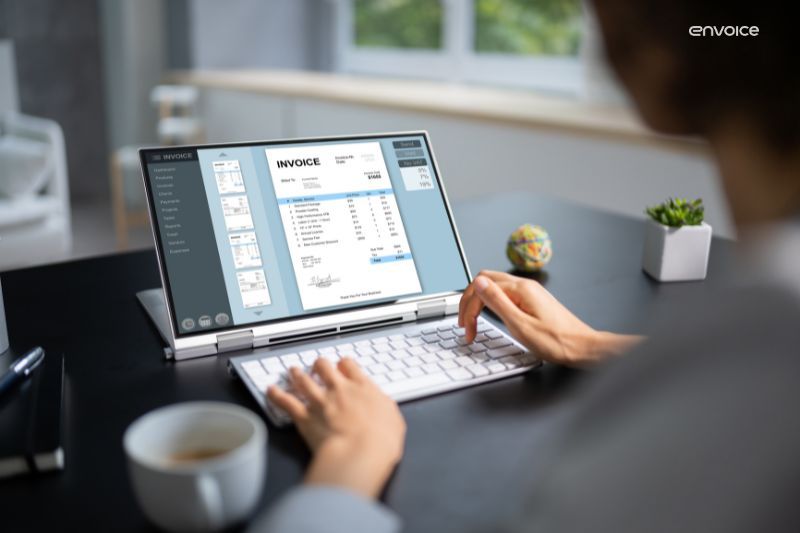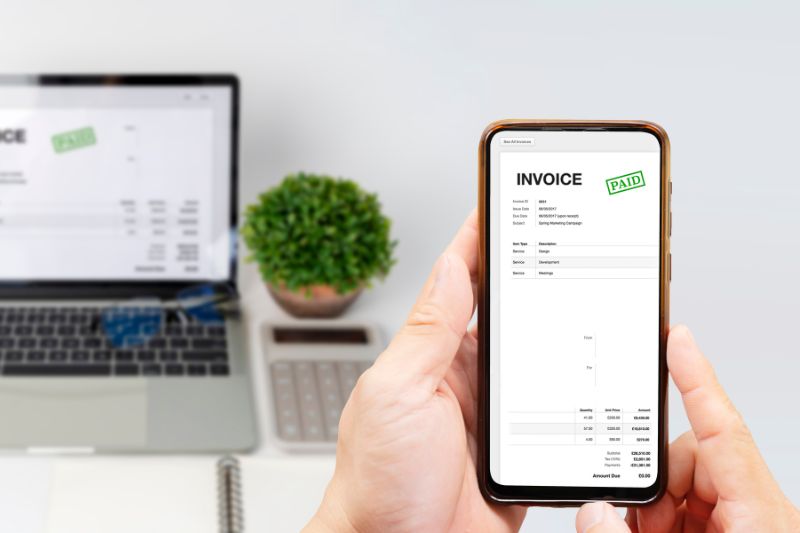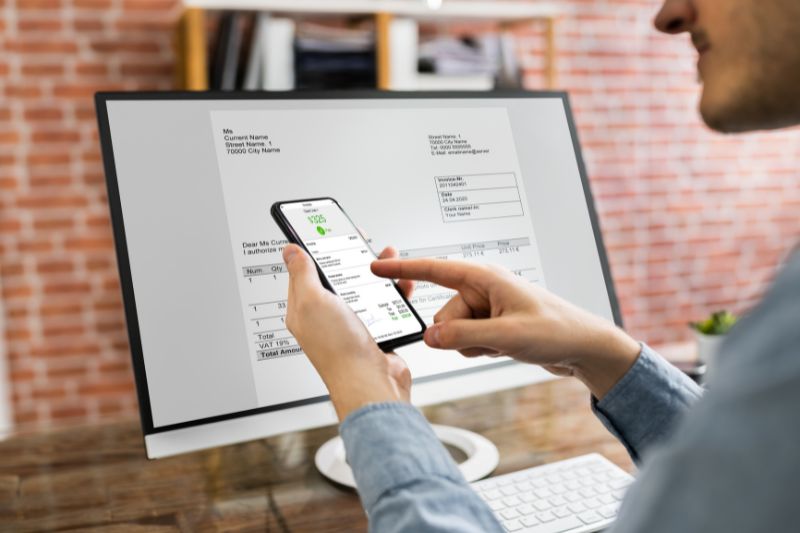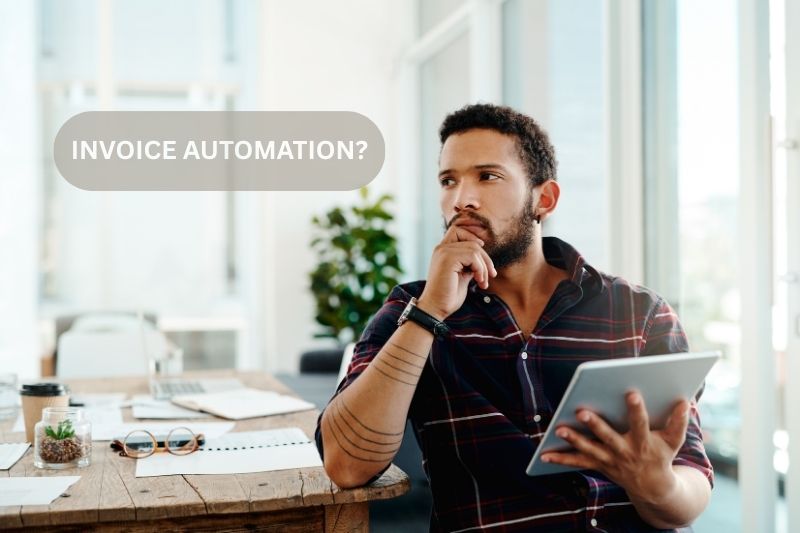Automated Invoice Processing: The Modern Invoice Approach

For the accounting industry, automation is a game-changer. Intelligent technology unlocks many opportunities and benefits, especially when processing supplier invoices. An automated invoice processing solution reduces processing costs, increases employee productivity, and enhances the accuracy of financial data.
If you are:
- Getting overwhelmed with the number of invoices you need to process to meet financial reporting deadlines.
- Struggling with late payments and vendor complaints.
- Running into expensive mistakes in invoice payments.
- Looking for a more effective way to reduce the time from the invoice received to the invoice scheduled for payment.
Automation could be the answer to your problems. This guide will walk you through the steps as you transition from a manual to an automated invoice approval workflow.
Don’t get left behind in old ways of invoicing when there’s a better way. Integrate Envoice with your existing software for a powerful automated invoice solution. Book a product demo.
What is Automated Invoice Processing?
Invoice processing automation is the use of technology to create more efficient ways to simplify and improve the effectiveness of your invoice process. Automation eliminates the need for manual data entry and paperwork validation because of its digital nature.
This is usually done by employing a suitable program, application, or accounting system to your ERP (Enterprise Resource Planning System) to facilitate processing invoices more efficiently from verification of data to approving and making payments.
Invoice automation software uses digital solutions like machine-learned systems, artificial intelligence, optical character recognition, and other innovative tools a small business can initiate and integrate into its workflow.
Most automated invoice processing software uses optical character recognition (OCR) to capture, store, and process data from physical documents like invoices. It uses algorithms to convert the embedded text in images into a digital format accurately and quickly.
Key Steps in the Automated Invoice Process
Step 1: Capture
The invoice processing starts with the collection of data from invoices. These invoices may come in different forms that the vendor may send over to your company. They can be structured, like dates, times, and names, that already have conventional formatting.
Invoices can also have unstructured data like images, spreadsheets, or text documents, which have no pre-defined information set.
Step 2: Data Extraction
OCR uses sophisticated algorithms to capture invoice data, process it, and store information without manual intervention. It is usually paired with another data extraction technology, such as machine learning, to verify that the data is accurate and complete.
Traditionally, when paper invoices arrive, a 3-way matching is made. By matching the purchase order with the delivered items, with the supply invoice, the verification team can check if the transaction is valid.
But automated invoice processing systems easily perform accounts payable functions by validating previous records, detecting supplier information, and avoiding payment scams.
Automated invoice matching can easily do multiple invoice matching in minutes, with an accuracy of up to 99%, depending on the software. AI-powered data validation does 2-way, 3-way, or even 4-way matching singly or by batch.
Step 3: Routing Invoices For Approval
In an automated invoice processing workflow, the verified invoices automatically route to the approver in the form of an email notification. They will then check and opt to reject the transaction, prompting the software to return the invoice to the client through email.
If the approver accepts the data, it will be submitted to the next approver, and repeats the process. The last approver will then decide if the invoice will be queued for payment processing.
Step 4: Automatic Payment Processing
With manual processes, a paper check is issued by the accounts payable department and mailed or picked up by the vendor. It can also be done through separate online platforms or wired-transferred via a bank.
This process may take longer than expected, especially if there are numerous approved invoices and clients to take into consideration.
As opposed to an automated invoice process, the approved invoices are sent straight for payment, automatically paying supplier invoices through the previously configured payment option.
For bulk invoice processing, you can choose and select invoices for batch payment and route them for processing on a certain date.
Step 5. Digital Storage and Archiving
With automated invoicing, data is stored and archived securely after payment has been processed. It is then filed online in your storage provider according to customizable categories so you and your team can get hold of important data with just a few clicks.
Don’t get left behind processing invoices manually. Envoice has a powerful automation tool that can read invoice information and import it into your existing accounting software. For $7 a month, you’ll receive the benefits of automated invoicing processing and much more. Sign up now, and don’t waste any more time or resources with manual data entry.
Why Automate Invoice Processing Now
Manual invoice processing may be a practical choice when you’re just starting out, but as you grow, things change. As the volume of invoices you receive increases, your business needs a better way to manage invoices. Managing invoices using software like Xero or Quickbooks helps but they don’t solve the problem.
Any inaccuracies in recording invoices could result in expenses being understated or overstated. Either way, you don’t have visibility into your company’s financial health – and this is why invoice automation is necessary as you scale your business. Further benefits of automation are:
- A saving in time
- Elimination of manual data entry
- Fraud prevention
- Lower invoice processing costs
- Improved data quality
- Early payment discounts
- Automated audit trails
- Real-time reporting
- Better cash flow management
- Improved vendor relationships
Transform your invoice process with Envoice. With smart rules based on the products or services you offer, every invoice will be accurate and delivered on time. See how Envoice has helped other accounting companies and businesses save time and money.
8 Steps For Implementing Automated Invoice Processing
Invoice approval automation takes most of the manual work out of processing invoices. By reducing human touchpoints, you can address many of the challenges associated with delayed invoice processing. Here are 8 steps for implementing automated invoice processing:
1. Assess Your Existing Invoice Processing Workflow
Kickstart your invoice automation efforts by analyzing your existing invoice processing workflow. The purpose of doing this is to spot inefficiencies and bottlenecks early. Focus on areas where automation will bring the most value.
2. Engage Key Stakeholders for Input
Second, gather stakeholder input and concerns. Include those in finance, IT, and procurement. Their involvement in implementing automated invoice processing is necessary for a successful and easy transition.
3. Install an Invoice Approval Workflow
Next, install the software. It’s better if it has a pre-built approval workflow, just like Envoice, that allows you to run manual approval workflows or apply an automated approval process.
4. Customize Your Workflow
Invoices typically go through several approvers. So, once the software is installed, the next step is to customize it to forward the invoice to the next approver.
A sample conditional invoice routing is from a manager (for review), sent as an email. If the amount involved is over $10,000, it should be routed to the VP for Finance and Administration. Then, the last step of the workflow is payment.
Conditional logic enforces compliance with the company’s internal policies and helps the invoice workflow more efficiently.
5. Assign Authorized Invoice Approvers
The next step of the implementation is assigning the invoice to the person tasked with payment and approval. Small business owners or designated managers and supervisors with budgetary controls are usually the ones who approve invoices.
However, company policy may require a second approval signature, especially for a particular amount. The second approver typically holds a higher-level position in the company.
6. Test and Review
Conduct thorough testing of the automated invoice processing system and approval process before actual use to address any issues. It’ll also be helpful to collect feedback from your internal stakeholders.
7. Perform User Acceptance
Perform user acceptance testing. This is where you train system users so they’ll be familiar with the software. In fact, regular performance testing is necessary to guarantee that expected results are met.
8. Continuously Monitor the System
The last part of the workflow is to monitor the performance and effect of your system continuously. If you see areas for improvement, make adjustments.
What Should You Look For in Automated Invoice Processing Software?
Choosing the right automated invoice processing solution is essential to maximize the benefits of digital invoicing. Here are a few features you can consider when making a choice:
| Feature | Description |
| Automation capabilities | Look for software that offers automation features, like invoice matching, automatic data capture, and approval workflows. These help accelerate the invoice processing cycle and reduce manual tasks. |
| Machine learning and OCR | Software with both capabilities will extract data faster and more accurately. As learning continues, the software begins to anticipate where data is stored. |
| Integration capabilities | The right software should integrate with your existing ERP, accounting, and other relevant systems to process invoices. These advanced technologies reduce manual data entry and streamline data flow. |
| Three-way matching | The three-way matching process involves verifying the invoice, goods receipt, and purchase order information. It is one of the best ways to ensure compliance, prevent fraud, and avoid errors in the invoicing process. |
| Intuitive user interface | The software should respond intuitively to user commands and be easy to navigate. |
| Approval workflows | Workflow approvals are key for AP automation and shouldn’t be skipped. This is usually a game changer when moving to an automated process. |
| Analytics and Reporting | Choose software that has standard reports and allows you to customize reports according to your company data needs. The software should have a dashboard where you can see the most important data at a glance. |
| Security and Encryption | All financial software must comply with the latest in encryption and security features, especially the payment gateways. |
How to Measure Invoice Processing Automation Success
Invoice processing automation is a straightforward solution for organizations searching to boost key performance indicators (KPIs) for their accounts payable.
To measure invoice processing automation success, you should account for:
Quantitative benefits include reduced costs (from lower fraud, no late payment penalties or duplicate payments, and labor productivity), efficiency merits, and improved cash flow.
Qualitative benefits include higher employee satisfaction because of better vendor relationships, increased visibility, improved compliance, and higher employee satisfaction from automating manual and repetitive tasks.
Some KPIs you can track include the following:
- Error Rate: Track errors, including data entry mistakes and duplicate payments, to evaluate accuracy.
- Processing Time: Calculate the time it takes to process an invoice from receipt to payment. A reduction in the processing time suggests increased efficiency.
- Cost per Invoice: Compute the cost of processing each invoice, including software and labor expenses. Lowering this cost marks increased efficiency.
- Supplier Satisfaction: Assess supplier satisfaction through feedback or surveys, as accurate and timely processing affects business relationships.
- Invoice Approval Time: Estimate the time it takes for invoices to be approved, reflecting the efficiency of your workflow.
Use this ROI formula to calculate the return on investment (ROI) of automated invoice processing:
ROI = (Benefits – Costs) / Costs x 100%
Automate Your Invoice Processing Today With Envoice
Finding ways to make technology work for you can be overwhelming, so selecting the invoice processing software that is all-inclusive and reliable is a must.
Envoice is our automated invoice processing solution of choice because not only does it make invoice management easier, but it also offers features for your pre-accounting activities, team collaboration, and comprehensive financial tracking.
Cross-media data capture
Reduce the volume of paperwork, and avoid missed and duplicate paper invoices, and manual data entry errors. Simply scan physical invoices or forward email copies so you don’t have to worry about losing or misfiling them. The multi-format data capture that supports various types of documents helps save time checking the mail or searching from folders.
Smart and accurate extraction
Eliminating the tedious encoding of data and traditional 3-way matching with digital invoices that does the verification in seconds. Envoice’s SmartRecord feature stores patterns like recurrent data, time, amount, and supplier information that will cut down your invoice processing time and costs.
Automates the invoice flow
Envoice also allows you to create smart rules based on the products and services you provide and the clients you serve or customers you sell to. This ensures that every invoice it makes is delivered on time and accurately.
Wide-range of customization
A reliable invoice automation software lets you customize bank and approval rules, so you can track payments and approval status. Upload payment orders to your bank account and sync them so you can monitor when suppliers have already received their payments.
Seamless integrations
With an automated invoice system that connects well with the tools you use every day, you don’t need to transfer files and databases or start from scratch. By integrating your digital accounting system, you can easily access everything in one platform from data capture to approval, payment, and storage.
Make Envoice your invoice processing automation solution today. Register for our free trial and start automating your AP processes. Still not sure? We look forward to talking to you and sharing our Envoice demo.
STAY ALWAYS TUNED
Subscribe to newsletter
Still not sure?
- Don’t spend time on manual work
- Streamline bookkeeping processes with AI
- Automate invoice processing
- Integrate with the tools you rely on every day











